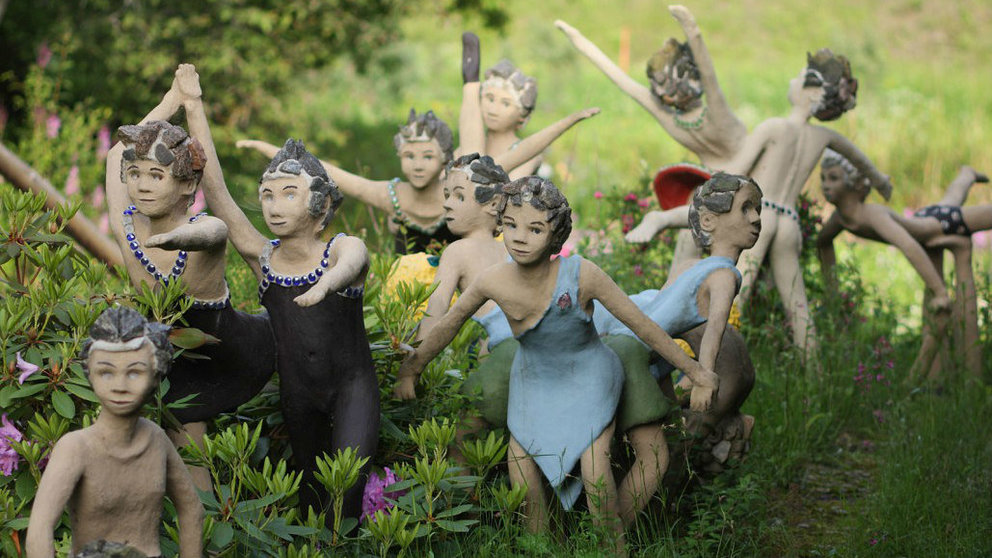Parikkala Statues Park (in Finnish Parikkalan Patsaspuisto) is one of those places that are disturbing to the senses, capable to test the visitors' ability to face their most intimate fears.
This is an unique place, fruit of the peculiar imagination of the self-taught artist Veijo Rönkkonen (1944-2010), an employee of a local paper mill who dedicated 50 years of his life to mould the almost 500 statues that fill the garden of his house.
The result is a crowd of figures that separately may reflect the author's peculiar personality and imagination. But altogether in this concrete space they give rise to a very unconventional environment, capable of generating in the visitor a complex set of sensations that change in seconds from curiosity to restlessness, nervousness and even trepidation.

This is due to the particular shape of the statues gathered in the park -mostly human- and their characteristics.
Their shapes are male, female, sometimes are indeterminate or they seem transvestite and there are also children. The author devoted less interest to developing some of their basic human features such as extremities or the expressions of the faces, but paid closer attention to a few details that accentuate their deep 'personality', if we may call it like that.
Thus, the eyes and the glances hidden behind them, sometimes vivacious, sometimes anxious, sometimes dead or even emanated from empty eye sockets, seem to chase one during the entire tour.
![Patsaspuisto 8]() The scaring dentures
The scaring dentures
Something similar happens with dentures, which sometimes reach a level of realism that give us goosebumps, and accentuate the feeling of helplessness before the multitude of figures. What would happen if suddenly all come to life?
One is not sure if they would be friendly or hostile to us, so sometimes feels more secure to stay away from some of them. Because the inhabitants of Parikkalan Patsaspuisto live their own reality and they make no sense outside of it. We humans are the strangers there, the foreigners, those who are alone.
In fact, when you get to the depths of the park you even come to think that all the statues could be also the representation of a single malignant being, determined to entertain us by showing itself in different shapes while chasing and observing us, expecting to discover our intimate weaknesses and take advantage of them.
Passion for yoga
Veijo Rönkkonen started sculpting in the 1960s. For fifty years he dedicated his free time to develop this form of art and to create the amazing garden in which the statues are located. At the core of the park, there are over 250 statues in different yoga positions. Rönkkönen himself practised yoga, so many of his works are barely disguised self-portraits.
Other big themes are depictions of different nationalities, occupations, and children playing, dancing and doing gymnastics.
The artist got recognition for his work during his lifetime. In 2007 received the Suomi Award from the Minister for Culture for his achievements in the field of art.
The location
Parikkala Sculpture Park is nowadays a popular place in Finland an receives 20,000-30,000 visitors per year. It is located in the Parikkala’s Koitsanlahti, along the Highway number 6, in the Finnish region of South Karelia, about 50 kilometres north the city of Imatra, close to the Russian border.
 There is a sign in the road that indicates its concrete location and a parking place nearby. From there, there is a direct passage to the park. Car is the best option to go. Trains from Helsinki to Joensuu stop in Parikkala. However, there is no public transport connection from the railway station to the park, so the only possibility if you travel to the region by train is to take a taxi afterwards.
There is a sign in the road that indicates its concrete location and a parking place nearby. From there, there is a direct passage to the park. Car is the best option to go. Trains from Helsinki to Joensuu stop in Parikkala. However, there is no public transport connection from the railway station to the park, so the only possibility if you travel to the region by train is to take a taxi afterwards.
The park is always open and you can pay a visit at anytime, around the clock, no matter if you want to do it during the day or in the middle of the night. Of course, under your own responsibility.
The author wanted the park to be a gift to the people, so he never considered to charge an entrance fee. However, the place receives no public funding for maintenance, so the current managers encourage visitors for a voluntary entrance fee (2.50 euros) to support its maintenance (2 euros in case of those who come in bus groups).
Visitors can pay in the collection poles located in the park or they can also contribute by visiting its boutique, which is open in June, July, August and during events.

Check the park's location in this map
If you want more information about this place, you can access the website of Parikkala Patsaspuisto HERE
*All photos included in this article made by Veli Granö








 The scaring dentures
The scaring dentures

